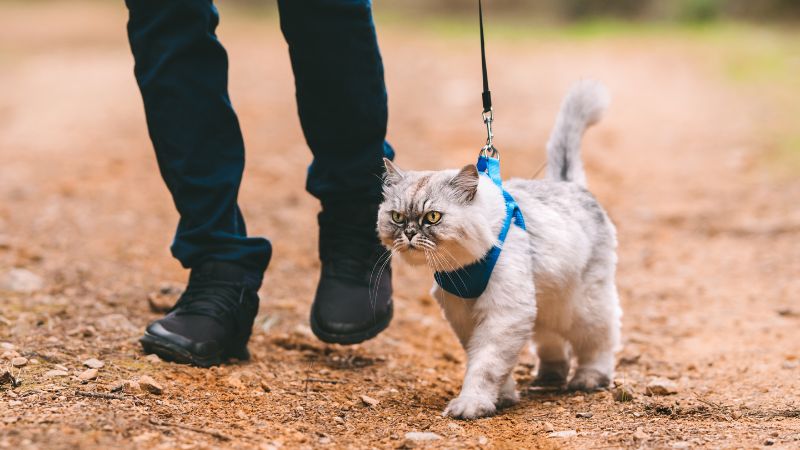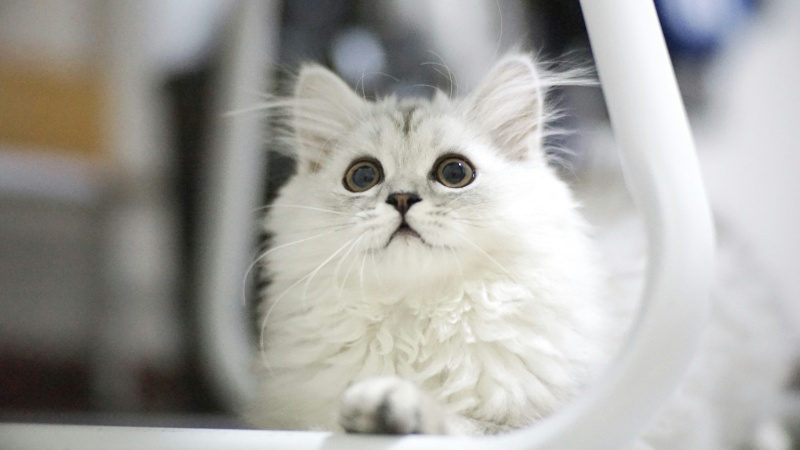
How To Craft A Cozy Cat Vest From Fabric Strips
Have you ever seen your feline friend lounging around and thought, “What could possibly make this picture more adorable?” The answer is simple: a cat

More and more cat owners are curious about leash training their cats, especially as we learn about the risks of letting them roam freely. But, the big question is: how do you actually train harness your cat?
We don’t usually train cats like we do dogs, and the idea of walking a cat on a leash can seem a bit daunting. So, in response to what you’ve been asking, I’ve put together this easy guide to help you get your cat used to a harness and ready for outdoor adventures.
Before we start, let’s make sure you have everything. Here is a list we need to prepare for harness training your cats. Let’s dive into the detailed Checklist:
A clicker can help, but it’s not a must
Teaching your cat to get used to a harness and leash can be done with or without a clicker. If your cat knows clicker training, awesome! Use it here. Whenever I talk about giving your cat a treat in this guide, you can just click and treat instead.
But don’t worry if you don’t use a clicker. You can still follow all the steps in this article. We’ll go through getting your cat comfortable with the harness and teaching them how to act with it. This involves gently introducing the harness and using treats to guide them into the behaviors we want, step by step.
Even though a clicker can help if your cat is used to it, it’s not a must-have. You can totally teach your cat to walk in a harness and leash without it!
Start by showing your cat the harness and leash. Just let them be around, not doing anything scary. Put them on the floor where your cat can see them. This is way before you even think about putting the harness on your cat.
Ask yourself: Is my cat chilly when I bring out the harness?
If yes, you’re ready for Step 2.
If not, keep on with this gentle introduction until they are.
Get some yummy treats ready for your cat and place the harness on the floor near them.
Remember, doing this repeatedly is important. Once your cat interacts with the harness, either move it somewhere else and do it again or put it away and bring it back after a few hours.
Repeat this a few times daily for several days at least. When your cat starts eagerly searching the harness for treats, or quickly comes over when you bring it out (because they’ve learned the harness means treats are coming), you’re ready for the next step.
Ask yourself: Is my cat happy and willing to approach or play with the harness when it comes out?
If yes, it’s time for Step 3.
If not, keep rewarding your cat whenever they come near, sniff, or touch the harness.
In this step, we aim to get your cat to willingly put on the neck part of the harness. This method is way better and creates happier feelings for your cat compared to forcing the harness on them. Remember, take it slow and let your cat set the pace based on how comfortable they are.
Begin by holding the harness with the neck opening ready, positioned around your cat’s head height. (Make sure to loosen the harness straps so there’s a big, easy opening – we’ll adjust it properly later). By now, your cat should be curious about the harness every time you bring it out. So keep giving them treats for sniffing or touching it while you’re holding it up.
Now, when your cat figures out that getting their head close to the loop means treats, don’t give treats for just sniffing anymore. Only give them a treat when they actually put their head in the middle of the loop or start poking their nose through it.
If your cat gets the hang of putting their head into the neck loop of the harness while you’re holding it, that’s awesome! But if they don’t do it by themselves, it’s totally okay to use a treat to help them along. Remember, don’t rush it. You shouldn’t expect your cat to wear the harness all the way the first time. Just let them start by getting a bit of their head through the loop, and then slowly encourage them to go further.
Tips: Oh, and if it’s hard to hold the harness and use a treat at the same time, getting someone to help can make a big difference.
This part might need you to do it over and over again. Once your cat is okay with putting their head all the way through the harness loop, it’s time to slowly stop using treats to make them do it. You want your cat to pop their head through the loop and stay there, waiting for their treat.
If your cat gets impatient – like pulling their head out and leaving – you might need to go back to using a treat but hold off a bit longer each time before giving it to them. This helps them learn to wait longer. In a perfect world, you’ll be able to let the loop just hang on your cat’s neck before you give them a treat at the end of this step.
Ask yourself: Is my cat cool with sticking their head through the harness and chilling there after you let go, without looking worried?
If yes, you’re ready for Step 4.
If not, keep giving your cat treats for even just getting their head a bit into the harness. Maybe try a yummier treat or make the harness looser.
Now, it’s time to see if your cat is okay with you fastening the belly strap of the harness. Some cats don’t mind at all, especially if they’re already cool by putting their heads through the neck loop. But, there are some cats who might not like it when you snap the buckle under their belly.
Ask yourself: Is my cat cool with you fastening the belly strap of the harness?
If they are, you’re good to go to Step 5.
If not, keep giving treats to your cat to let you mess with the straps around them. Then, slowly work towards getting the harness all the way closed.
After you’ve managed to fully get the harness on your cat, don’t rush to adjust the straps right away. It’s more important that your cat gets comfy with just wearing it. By now, your cat should be okay chilling in the harnessed-up without panicking or trying to escape. So, turn the times they wear the harness into super fun times.
Each day, put the harness on your cat for a little while. During this time, give them all your attention. Cuddle them, stroke them, or throw some treats for them to chase.
Maybe bring out a new toy. You want to find activities that are fun (so they always associate the harness with good times) and also get your cat moving. This helps them get used to the feel of the harness moving on them.
When your cat seems fine with the harness, you can then adjust it to fit them properly. Some cats won’t mind you doing this, but others might need treats to stay still while you fiddle with the harness. If that’s the case, having someone else feed your cat while you adjust makes things way easier.
Start increasing how long your cat wears the harness bit by bit. You’re aiming for them to wear it so comfortably that they forget it’s there and just do their normal stuff.
(But don’t leave your cat alone in the harness, okay? If they get tangled up and panic, it’s dangerous and could wreck all the work you’ve done getting them used to the harness.)
Now, it’s time for the leash. Some cats might be cool with it right off the bat, but others might be a bit nervous. If your cat seems nervous, remember what we did in steps one and two of this guide. Get your cat to see the leash as a good thing, something they’re okay with touching.
Gradually work up clipping the leash to the harness and let your cat walk around inside with the leash trailing behind them.
Now, your cat knows how to wear a harness! Once you’re sure the harness fits snugly and your cat is cool with the leash, grab the leash and let your cat check out the great outdoors!
But hey, getting your cat to actually walk with you, like on a proper walk, is a whole different thing. Cats usually like to wander and sniff around on their own, not walk next to you like dogs do. (Don’t worry, I’ll be sharing how to train your cat to walk where you want them to go in my next post!)
What type of harness is best for cats?
-A well-fitted, adjustable, and comfortable harness is ideal. Look for ones specifically designed for cats as they are tailored to fit their body shape. But a vest harness is best for cats.
What do I do if my cat refuses to move while in the harness?
-Give them time to adjust. Stay patient and keep the environment calm and positive. Encourage movement with treats or toys.
How long does it usually take to harness-train a cat?
-The time it takes can vary greatly depending on your cat’s personality and comfort level. Typically, it can take anywhere from a few days to several weeks.


Have you ever seen your feline friend lounging around and thought, “What could possibly make this picture more adorable?” The answer is simple: a cat

The moment you consider a dog hunting vest for your adventurous companion, you’re stepping into a world where safety meets functionality. This vest is not

The concept of a dog cooling vest is a game-changer for pet owners looking to enhance their dog’s comfort during those relentless summer days. Imagine

When you first consider crafting a tactical dog vest, it’s not just about embarking on a fun DIY project; it’s about ensuring your furry companion’s

Have you ever seen your feline friend lounging around and thought, “What could possibly make this picture more adorable?” The answer is simple: a cat

The moment you consider a dog hunting vest for your adventurous companion, you’re stepping into a world where safety meets functionality. This vest is not

The concept of a dog cooling vest is a game-changer for pet owners looking to enhance their dog’s comfort during those relentless summer days. Imagine

When you first consider crafting a tactical dog vest, it’s not just about embarking on a fun DIY project; it’s about ensuring your furry companion’s
Secure and Empower, Walk Responsibly
Copyright © 2025pettacticalharness. All Rights Reserved.